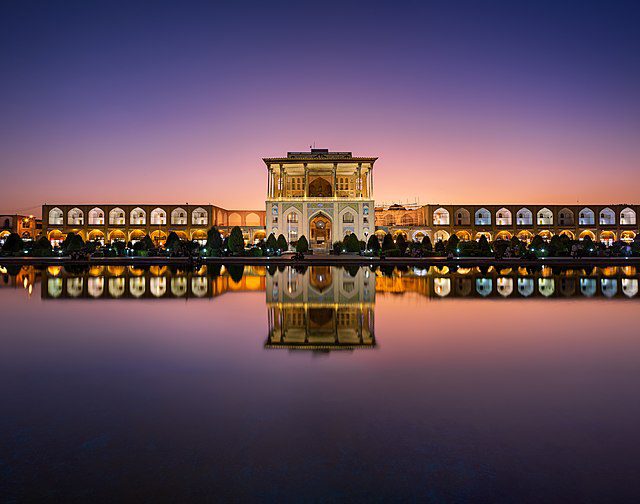Table of Contents
Standing proudly on the western side of Imam Square in Isfahan, the Ali Qapu Palace is a striking six-story building dating back to the Safavid era, around the early 11th century AH. Named after the Safavid ruler Ali I, this palace used to be the biggest building in the capital, shining like a jewel in Isfahan. But what makes it stand out isn’t just its age—it’s the stunning decorations that adorn it, catching the eye of every visitor.
The intricate plasterwork, showcasing some of the finest Iranian art, adds an extra layer of beauty to the palace. For decades, its towering height of around 36 meters made it the tallest multi-story mansion in Isfahan, creating a truly breathtaking sight.
Among all the other must-see attractions of Isfahan, the Ali Qapu Palace is a remarkable example of Safavid architecture and craftsmanship. Its tall presence, once a symbol of power and grandeur in the city, continues to impress travelers and history enthusiasts alike. As visitors explore its halls and admire its intricate decorations, they’re transported back in time to an era of cultural richness and imperial glory.
Beyond its architectural significance, the palace stands as a tribute to Iran’s artistic heritage, inviting everyone to appreciate its enduring beauty and immerse themselves in the history of this magnificent structure.
Ali Qapu History
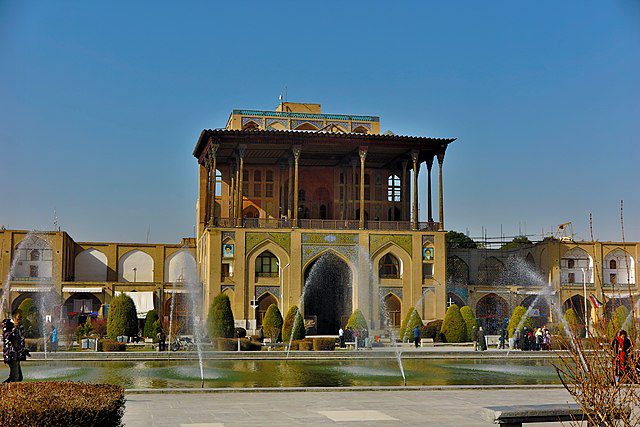
When King Abbas I moved the Safavid capital to Isfahan in the late 16th century, construction began on what would become Ali Qapu. Originally just an entrance to the Safavid government, it soon became the central gateway connecting the grand palaces in Naqsh e Jahan Square, now known as Imam Square. Its story starts with mystery, with historians debating when it was built. Archaeological digs in the Pahlavi era confirmed it as a Safavid creation.
Made of simple brick, it bore the marks of Safavid craftsmanship, showing it was part of Isfahan’s original plan. Over 70 to 100 years, it grew and changed under different Safavid kings, like Abbas II and Solomon. Even as Safavid rule waned, King Sultan Hussein added his touch, leaving inscriptions that tell us of Ali Qapu’s enduring importance.
Ali Qapu Palace Architecture
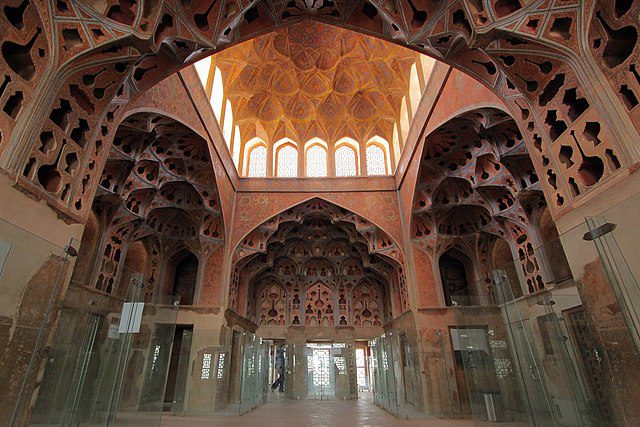
Ali Qapu Palace is a marvel of architecture that took about 70 years to build. It stands tall at 48 meters high and looks like it has 2 floors from the front and 5 from the back, but there’s a surprise waiting inside – it has 6 floors!
The first three floors were used as offices where people could come for official business. They’re pretty plain compared to the rest of the palace. You can get to the upper floors using spiral staircases with colorful tiles. The fourth floor has a cool terrace where you can see the famous Naqsh-e Jahan Square and two big mosques. It’s said that the king, Shah Abbas, used to hang out here, watching polo matches and enjoying the view.
But the real highlight is the sixth floor – it’s covered in beautiful designs made of plaster. They call it the Music Hall because the sound in there is amazing. It’s like being in a magical place where music fills the air and makes everything feel special.
Ali Qapu Music Hall
Located within Ali Qapu’s intricate architecture lies a special spot: the Music Hall. Among its many wonders, this hall shines bright, inviting visitors to explore its rich history and clever acoustics. Standing tall on the sixth floor, it was the perfect place for the king’s grand gatherings and fancy parties.
What makes it unique isn’t just its fancy design, but its smart acoustic setup – a cool trick without any fancy tech. Inside, the air would hum with the sweet sounds of traditional Persian instruments like the setar, kamancheh, and daf, making the king and his guests feel like they were in a magical world of music and joy.
How to Get to Ali Qapu Palace
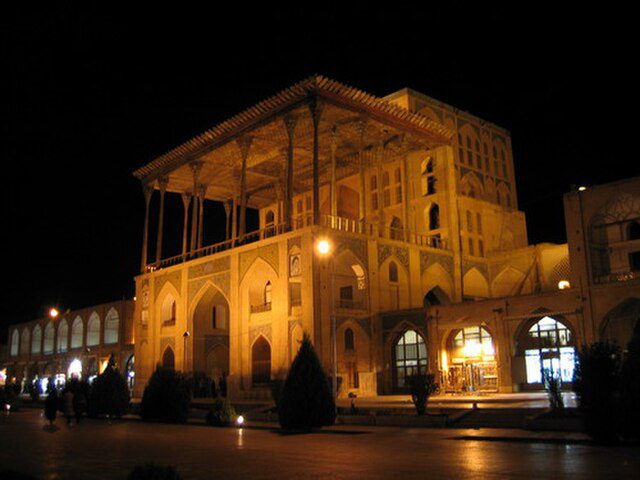
By Car
If you’re driving, just head to Ostandari Street for parking. You’ll find spots near the square’s western wall and Shah Mosque’s eastern side, making it easy to park and walk into the heart of the square.
On Foot
Prefer walking? Start from nearby places like Hasht Behesht Palace, Chehel Sotoun Palace, Si-o-Se-Pol Bridge, the Bazaar, or the Historical Bath. They’re all close enough to each other for a nice walk to Naqsh-e Jahan Square and eventually to Ali Qapu Palace.
By Metro
If you’re coming from afar or the airport, taking the metro to Takhti station is your best bet. From there, it’s just a 20-minute walk to the square, giving you a convenient ride and a short stroll to your final destination.
By Bus
Taking the bus? Look for routes passing Central Library or Khorshid Hospital stops. Both stops are close to Naqsh-e Jahan Square, making your journey to Isfahan’s heart easy. Once you arrive, it’s just a brief walk to immerse yourself in the splendor of this palace.
Recommended Sightseeing Time of Ali Qapu Palace
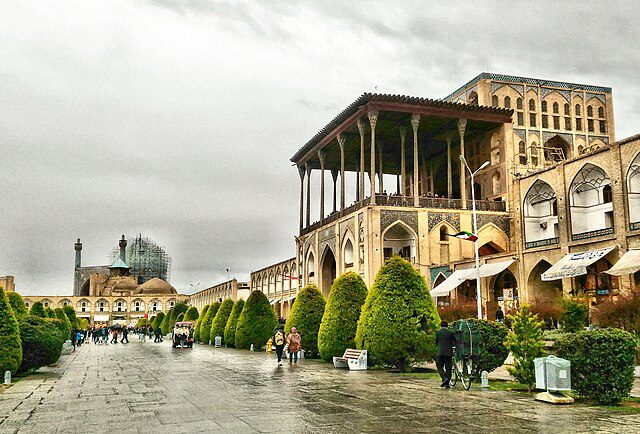
The perfect time to check out Ali Qapu Palace is during spring (April to June) and fall (September to November). These seasons give you the best weather and scenery to enjoy this stunning historical site. In spring, when flowers bloom and trees come back to life, the palace looks even more impressive against the backdrop of nature. And in fall, with all the warm colors around, exploring the palace feels like stepping into a painting.
Whether you prefer the fresh blooms of spring or the cozy vibes of fall, visiting this palace during these times ensures a memorable journey through time and beauty.
Working Hours of Ali Qapu Palace
Ali Qapu Palace opens its doors to visitors from 9:00 AM to 5:00 PM daily, offering a window of opportunity to explore its timeless beauty and historical significance.
Where to Eat Near Ali Qapu Palace
Roozegar
When you’re near Ali Qapu Palace in Isfahan, don’t miss out on Roozegar. It’s like stepping into a tasty time machine, with smells that’ll make your mouth water. They serve up classic Persian dishes like saffron rice and juicy kebabs that’ll make your taste buds dance with joy.
Haj Esmail Cheloe
For a taste of real Persian cooking, Haj Esmail Cheloe is the place to be. It’s cozy and welcoming, and the food is made with love using fresh, local ingredients. From hearty stews to fruity rice dishes, every bite is like a hug from Iran’s culinary history.
Partikan Hotel Restaurant
As the sun sets over Ali Qapu Palace, head to Partikan Hotel Restaurant for a meal you won’t forget. It’s fancy but still friendly, offering a mix of classic Persian flavors with a modern twist. With every dish crafted to perfection, dining here is an experience you’ll cherish long after you leave.
Where to Stay Near Ali Qapu Palace
Hasht Behesht Apart Hotel
Located in Isfahan’s historic heart, Hasht Behesht Apart Hotel offers a calm retreat for visitors exploring Ali Qapu Palace. The hotel’s cozy apartments blend modern comfort with Iranian warmth, ensuring a pleasant stay. Whether you’re admiring the palace’s architecture or wandering Isfahan’s streets, Hasht Behesht Apart Hotel provides a convenient base for your adventures.
Ghasr Monshi Hotel
Ghasr Monshi Hotel, close to Ali Qapu Palace, blends history with modern comforts. Its elegant décor and attentive service create an inviting atmosphere. Guests can relax in the hotel’s gardens or savor delicious meals in its restaurants. Whether you love history or simply seek luxury, Ghasr Monshi Hotel offers a memorable stay near Ali Qapu Palace.
Setareh Hotel
Setareh Hotel welcomes guests with open arms, providing a warm and inviting atmosphere just a stone’s throw away from Ali Qapu Palace. Offering comfortable accommodations and friendly service, this hotel ensures a memorable stay in Isfahan. With its convenient location and affordable rates, Setareh Hotel is the perfect choice for travelers seeking a cozy and budget-friendly option near the palace.
Other Attractions Near Ali Qapu Palace
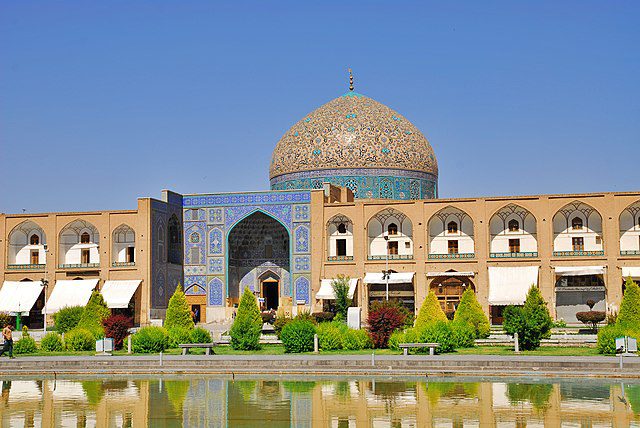
Sheikh Lotfollah Mosque
Besides Ali Qapu Palace, Naqsh-e Jahan Square boasts three other must-see spots. One of them is Sheikh Lotfollah Mosque, a stunning example of Safavid architecture. It’s smaller than the other mosques nearby but packs a big punch with its beautiful designs. Inside, you’ll find yourself surrounded by intricate tiles and patterns that create a peaceful atmosphere. Don’t miss the chance to admire the domed ceilings, where sunlight plays hide-and-seek, adding to the mosque’s charm.
The Grand Bazaar
Step into the lively Grand Bazaar, a hub of Iranian culture and commerce. Here, you can get lost among the maze-like streets filled with vendors selling everything from crafts to spices. It’s a vibrant place where bargaining is the norm, and every corner hides something new to discover.
Whether you’re shopping for souvenirs or simply soaking up the lively atmosphere, the Grand Bazaar offers a glimpse into the heart of Isfahan’s bustling life.
The Shah Mosque
Another fantastic spot near Ali Qapu Palace is the Shah Mosque. It’s a big, beautiful building from the Safavid times. When you step inside, you’ll be amazed by how grand it is, with its tall towers and pretty tiles. The prayer hall is especially stunning, with lots of colorful mosaics and fancy writing on the walls. Walking around the courtyards and looking up at the shiny blue domes, you can feel the history and culture of Isfahan all around you.
Khaju Bridge
Right near Ali Qapu Palace is the famous Khaju Bridge, stretching over the Zayandeh River. It was built a long time ago and has been a popular spot for locals and visitors ever since. You can take a nice walk along the bridge, listening to the peaceful sound of the river below. When the sun goes down, the bridge lights up, making it a magical place to be with its beautiful views of Isfahan.
FAQs about Ali Qapu Palace
Q1: Why is the Ali Qapu Palace important?
A1: The palace was where Persian Emperors from the Safavid dynasty lived. UNESCO marked it as a special place in the world because of its cultural and historical value. It’s really tall, 48 meters, with six floors that you can only reach using a tricky spiral staircase.
Q2: How big is the Ali Qapu Palace?
A2: Ali Qapu sits on the western side of Naqsh-e Jahan Square. The palace stands tall at 48 meters and covers an area of 1500 square meters, making it a truly impressive structure.
Q3: Why was the Ali Qapu Palace built?
A3: Constructed towards the end of the 16th century, this six-story palace was originally made as a home for Shah Abbas I. It also acted as a grand entrance to the royal palaces located in the parklands beyond. The name “Ali Qapu” translates to “Gate of Ali.”
Q4: When was Ali Qapu Palace made?
A4: The Ali Qapu Palace was constructed in the late 16th century, under the rule of Shah Abbas I of the Safavid dynasty. Building work started around 1592 and finished around 1598.
Q5: What is the height of Ali Qapu Palace?
A5: Ali Qapu Palace stands tall at approximately 48 meters high.
Last Words: Explore the Best of Ali Qapu Palace with a Customized Tour
The Ali Qapu Palace in Isfahan is a very tall building built in the old days. It’s named after a ruler called Ali I. This palace used to be the biggest building in Isfahan, and it’s famous for its beautiful decorations, especially the fancy plasterwork. Its height made it stand out, being the tallest multi-story mansion in Isfahan.
If you want to make the most of your trip and enjoy your time at Ali Qapu Palace, it’s smart to choose a personalized tour. That’s where To Iran Tour comes in. We’re experts at making custom travel plans that suit what you like to do, whether it’s exploring historical sites, trying local food, or just soaking up the scenery.
With To Iran Tour, your dream of seeing Ali Qapu Palace and more is closer than ever. Get ready for an incredible adventure through Iran’s wonders!

